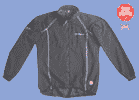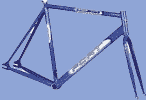Winter Cycling
Whether you race, tour, or just want to enjoy cycling by being a bit fitter. You need to ride your bike during the colder months of the year.
Lets face it, in this country there are three seasons when it can be cold, in truth probably four, and if we only rode our bikes when it was sunny, we may not ride the bike very often. 
Riding your bike in the colder months can be as enjoyable as riding in the summer if you take a few precautions.
First, you may have heard the expression that there is no such thing as bad weather when it comes to cycling, only bad or poor clothing. This in most instances is probably true because with the advancements there has been in cycle clothing, you can easily ride similar distances as you do in the warmer months and still arrive home relatively unscathed.
Second, we would suggest you don't use your best, or summer bike for sloshing around in the winter. Get yourself a training bike, sometimes referred to as a 'hack bike'. Why?
- Well, wet and salted roads do a bike no favours at all.
- You will often put the bike away wet or damp - rust just loves these conditions
- Your summer bike may not have mudguards fitted. (Guards are a real bonus both for the bike and you, that is unless you like the thin wet/muddy streak running from your bum up to your neck).
- If you are taking part in 'club or group rides' you will probably be expected to have guards fitted. Sitting behind a bike with no guards, on wet roads, is no fun.
Advice and guidance about Technical clothing.
Staying warm, (or cool for that matter) is a question of wearing the correct type of clothing. Many think that less heat - more clothes is the answer, yet the wrong clothing can be counterproductive in your quest for warmth.
We explain all you need to know regarding the three layers of technical clothing guaranteed to keep you warm or cool. We also explain the benefits of specific materials including Gore-Tex® and Windstopper® Soft Shell fabrics
Wicking base layers
 These are the "next to the skin layers" which play a major part in your comfort. They keep your skin dry and free from perspiration. To do this they have to be made of fabrics that "wick" - pull moisture away from your skin by capillary action so that it can evaporate on the outside of the fabric or pass through other layers. Base layers also provide insulation.
These are the "next to the skin layers" which play a major part in your comfort. They keep your skin dry and free from perspiration. To do this they have to be made of fabrics that "wick" - pull moisture away from your skin by capillary action so that it can evaporate on the outside of the fabric or pass through other layers. Base layers also provide insulation.
Insulating mid layers
 The traditional role of mid layers is to keep us warm by trapping our own heat and using it for insulation. Fleece is an effective insulator with a high warmth to weight ratio. Different thickness of fleece provide different levels of insulation with thicker being warmer. Using fleece with different characteristics - stretch, windproofing, wicking and water resistance you can create a micro climate around your body to suit every type of cycling.
The traditional role of mid layers is to keep us warm by trapping our own heat and using it for insulation. Fleece is an effective insulator with a high warmth to weight ratio. Different thickness of fleece provide different levels of insulation with thicker being warmer. Using fleece with different characteristics - stretch, windproofing, wicking and water resistance you can create a micro climate around your body to suit every type of cycling.
Weatherproof shell layers
 This layer defends us from the elements allowing the other layers to work effectively. These garments provide the ideal balance of weatherproofing and breathability. They are also exceptionally durable and often totally windproof and waterproof.
This layer defends us from the elements allowing the other layers to work effectively. These garments provide the ideal balance of weatherproofing and breathability. They are also exceptionally durable and often totally windproof and waterproof.
Gore-Tex®
One of the best known materials used to produce weatherproof garments is Gore-Tex®. In the past Classic Gore-Tex® was used which whilst having excellent resistance to rain and wind, could have breathed better that it did.
 Gore-Tex® XCR is a new 100% waterproof, windproof and breathable fabric. It is the most breathable, waterproof fabric on the market, 25% more breathable than Classic Gore-Tex®.
Gore-Tex® XCR is a new 100% waterproof, windproof and breathable fabric. It is the most breathable, waterproof fabric on the market, 25% more breathable than Classic Gore-Tex®.
3 layer XCR, as used by Freestyle clothing, is also more durable than previous materials. Also all Freestyle Gore-Tex® garments are heat sealed and taped on ALL seams, not just the major seams.
All Gore-Tex® fabrics are machine washable which does not affect the waterproofing of the garment. Rather, you are encouraged to wash your garment every 2-3 weeks, drying it in a tumble dryer. This clears the pores in the membrane and the heat regenerates the water repellency.
For a full range of Gore-Tex® waterproof and windproof jackets as manufactured by Freestyle, within the UK, then click the image above or any of the previous links.
Windstopper® Soft Shell fabrics
 Windstopper® Soft Shell fabrics, also produced by Gore, define a new balance between the comfort and protection of a garment.
Windstopper® Soft Shell fabrics, also produced by Gore, define a new balance between the comfort and protection of a garment.
These fabrics combine the soft, comfortable fit of a mid layer with the reliable shell protection against biting cold wind, light rain and snow, while allowing moisture vapour to easily escape during high activity. The secret is the unique combination of the high performance Gore membrane technology and a durable water repellant treatment (DWR) of the face fabric.
Head gear
 No horror stories, though we could tell one of why you should not really dispense with the helmet in preference to a warm wooly hat in winter. Non scientific testing (I fell off my bike) has proven that a wooly hat does not offer the same level of protection as does a helmet. There are many forms of thin insulating headcovering available which can easily be worn under your helmet, you often only have to adjust the chin strap.
No horror stories, though we could tell one of why you should not really dispense with the helmet in preference to a warm wooly hat in winter. Non scientific testing (I fell off my bike) has proven that a wooly hat does not offer the same level of protection as does a helmet. There are many forms of thin insulating headcovering available which can easily be worn under your helmet, you often only have to adjust the chin strap.
Hand gear
 Invest in various forms of winter glove to suit the conditions in which you prefer to ride. Alternatively buy an insulated pair, it's better to have your hands sweating because it gets warm, rather than suffering cold digits, closely followed by the hot stinging pains as the blood returns to your hands.
Invest in various forms of winter glove to suit the conditions in which you prefer to ride. Alternatively buy an insulated pair, it's better to have your hands sweating because it gets warm, rather than suffering cold digits, closely followed by the hot stinging pains as the blood returns to your hands.
Footwear
 How many bike rides have been spoilt because of cold feet? Cold feet can be marginally worse that cold hands. So, what can you do about it?
How many bike rides have been spoilt because of cold feet? Cold feet can be marginally worse that cold hands. So, what can you do about it?
You'll possibly need to invest in shoes or boots specifically for the winter; summer shoes are useless in the winter.
Alternatively cover your summer shoes with cycle overshoes that are either waterproof or offer insulation. Most cyclists seem to have a second pair of shoes specifically for the winter. These are either winter boots as mentioned above, or a larger size of summer shoes that enables them to wear thicker socks which they then also cover with cycle overshoes.
The bike
 Get yourself a training or 'hack bike'. Fit mudguards and lights to it. Use wider tyres than normal and consider those with a Kevlar content; whilst they will not prevent punctures, they should reduce the number you have. Consider the use of gas cannisters for re inflating tyres, alternatively always make sure you have a good pump.
Get yourself a training or 'hack bike'. Fit mudguards and lights to it. Use wider tyres than normal and consider those with a Kevlar content; whilst they will not prevent punctures, they should reduce the number you have. Consider the use of gas cannisters for re inflating tyres, alternatively always make sure you have a good pump.
For further information about the legal issues surrounding cycle lighting, follow this link.